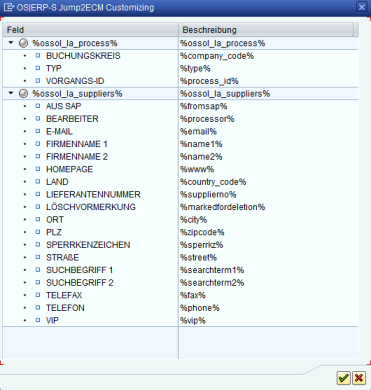Customizing jump2ecm
In the OS-specific customizing interface in SAP, you define which business objects the jump is available on, the properties of these objects that are used to make the jump, and to which folder in enaio® client the jump is made.
Both jumps and data transfers can be configured in the same customizing interface.
Call
The enaio® jump2ecm Customizing interface can be accessed using the SAP transaction call /n/OSGMBH/J2E_CUST. The transaction is available after the transport for enaio® jump2ecm has been imported and authorization has been given to perform the transport.
License
The 'J2E' license is required to use enaio® jump2ecm. The license is checked against enaio® server whose login data must be maintained.
Installing the Object Service
The object service for the jump must be installed one time for each SAP system. To do this, the Install object service for jump menu item must be enabled in enaio® jump2ecm Customizing if the traffic light is red. The object service is installed on all clients.

As a result, an entry is made in the SAP table of attributes of generic services (SGOSATTR).
These attributes define, among other things, where the enaio® jump2ecm entry appears in the menu of the generic object services. OS recommends adding it after the attachment list (VIEW_ATTA).


If there is no more than one target point (one record) in enaio®, tick Simple service if you do not want to expand the list at this point.
The Jump2ECM > Remove object service for jump menu item can also be used to remove the object service again in order, for example, to reinstall it at a different location.
Systems
At least one enaio® data2ecm system must be maintained per customer in the 'Systems' area ('Create system' button) if this has not already been done via enaio® Customizing. enaio® data2ecm and enaio® jump2ecm use the same enaio® systems.

The password of the enaio® user may not begin with ! or ? .
The 'Connection test' button can be used to check if there is contact to the web service. This is required for:
-
the license check,
-
input help when customizing the settings, and
-
jumps from SAP to enaio®.
Jumps
New jumps can be created for each customer via the context menu.
These are entered in the tree under the customer. The customized settings that need to be entered are made on the right in the workspace.
At this time, you define from which locations in SAP (from which object type) jumps are made in enaio® client and using what data.
The technical names of the cabinets in the systems to which the jump is to be made are assigned to the SAP systems under 'System assignments'. The technical names of the registers and documents can also be maintained contingent on the system.
SAP to enaio® fields are assigned under 'Variables'.

The following values must be entered:
|
Field |
Description |
|---|---|
|
Jump |
User-defined name |
|
Menu text |
User-defined name (shown to users) |
|
Object type |
SAP object type |
|
Active |
Flag indicating whether jump configuration is enabled |
|
Register |
Target object (if jump not made directly to the cabinet) |
|
Documents |
Target object (for displaying a document list) |
|
Extension class |
Class for project-specific extensions (optional) |
|
Show/hide class |
Used to implement a class that influences whether a jump is visible in the generic object services. Example: /OSGMBH/CL_JUMP2ECM_FILTER |
In the variable table, the properties of the jump object type or project-specific fields determined by the extension class can be linked to the target fields of the enaio® record. When the jump is executed, the values of the SAP fields are then entered in the assigned fields of the enaio® objects for execution of a query.
The following syntax is valid for the input of the target field in the record, which is automatically applied when using input help:
%<internal name of target object (cabinet/register)>%@%<internal name of target field>%
The names for the cabinet, register, and fields can also be specified using your display name (without the percent signs). The internal names are preferable because they are unique and easy to maintain, especially in the case of multi-language records.
The %%CABINET%% placeholder is dynamically replaced at runtime with the cabinet maintained in the system mappings.

Input help is available to assist you in selecting the SAP field. This offers the properties belonging to the SAP object type specified above as well as the additional fields of the enhancement class.

Instead of an SAP field, a fixed value can also be entered and additional specifications for offset and the output screen are possible (for example, conversion routine ==ALPHA for omitting leading zeros).

Other Editing Features
The following buttons which may come in handy are available above the customer jumps tree:
|
Field |
Description |
|---|---|
|
Copy |
Copy jumps |
|
Deleting a Link |
Delete transfers |
|
Test |
Functional test of a jump configuration: The jump-specific selection values must be entered in order to perform the test. |
|
Transport |
Individual or all jumps (and transfers) of a customer can be assigned to a transport order. |
|
Switch |
It is possible to switch to a view sorted by business object from the view of jumps sorted by customer. |
 areas. Use the toolbar to show all hidden areas at once:
areas. Use the toolbar to show all hidden areas at once:
